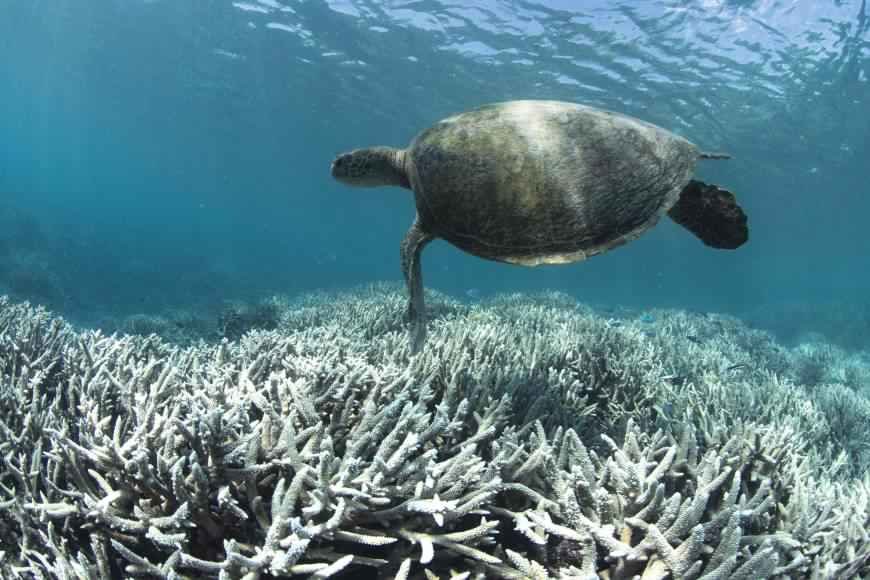
© AFP-JIJIA turtle swims over bleached coral at Heron Island on the Great Barrier Reef.
Australia's Great Barrier Reef is suffering its worst coral bleaching in recorded history with 93 percent of the World Heritage site affected, scientists said Wednesday, as they revealed the phenomenon is also hitting the other side of the country.
After extensive aerial and underwater surveys, researchers at James Cook University said only 7 percent of the huge reef had escaped the whitening triggered by warmer water temperatures.
"We've never seen anything like this scale of bleaching before," said Terry Hughes, convenor of the National Coral Bleaching Task Force.
The damage ranges from minor in the southern areas — which are expected to recover soon — to very severe in the northern and most pristine reaches of the 2,300-km-long (1,430-mile-long) site off the east coast.
Hughes said of the 911 individual reefs surveyed, only 68 (or 7 percent) had escaped the massive bleaching event which has also spread south to Sydney Harbor for the first time and across to the west.
Researcher Verena Schoepf, from the University of Western Australia, said coral is already dying at a site she had recently visited off the state's far north coast.
"Some of the sites that I work at had really very severe bleaching, up to 80 to 90 percent of the coral bleached," she said. "So it's pretty bad out there."
Australian Environment Minister Greg Hunt said it is
"absolutely clear that there is a severe coral bleaching event occurring not just in the Great Barrier Reef but throughout many parts of the Pacific."
Hughes said the bleaching began in Hawaii late last year and has already affected several Pacific islands.
"Right now, New Caledonia, the Coral Sea, the northern half of the Barrier Reef and New South Wales are bleaching severely, and Western Australia is quickly catching up," he said.
Bleaching occurs when abnormal environmental conditions, such as warmer sea temperatures, cause corals to expel tiny photosynthetic algae, draining them of their color.Corals can recover if the water temperature drops and the algae are able to recolonize them, but scientists warned last year that the warming effects of an El Nino weather pattern could result in a mass global bleaching event.
Hughes said while bleaching has been linked to El Ninos, which generally occur every four to six years, "it wasn't until 1998 that one finally caused a bleaching event to happen" on the Great Barrier Reef.
"So the issue is global warming," Hughes said, saying
the link between water temperature and the severity of the bleaching is clear.Hughes said the impact on the Great Barrier Reef would have been even worse had not a tropical cyclone which smashed into the Pacific island of Fiji in February brought rain and cooler weather to parts of Queensland.
"If you think about it, being rescued by the vagaries of a cyclone is a fairly precarious place to be," he added.
Andrew Baird, from James Cook University's center for coral reef studies, said he had been surprised by the scale and severity of the event on the major tourist draw card, which is teeming with marine life.
"We've been expecting a really big event for a while I suppose and here it is," he said.
Baird said because the bleaching is far less serious in the southern reaches "lots of the reef will still be in good shape."
"But the reef that's been badly affected — which is a third to a half of it — is going to take a while to recover," he said.
"And again the big question is how many of these events can it handle? And I think the answer is not many more."
Comment: With so many volcanoes erupting recently, a comparable escalation in activity of their underwater counterparts seems logical. It is estimated there are up to one million submarine volcanoes on our planet.
Effects from this volcanic activity, combined with increased methane outgassing and radiation from the Fukushima disaster are probably creating the 'abnormal environmental conditions' contributing towards this devastating coral bleaching and the ongoing devastation of marine life, mass fish die offs and strange migratory behaviour we are currently witnessing.
See also: Australia's Great Barrier Reef on brink of collapse